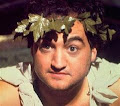The Soused Cinema Library: The Comedy of Charlie Chaplin - Artistry in Motion
>> Sunday, July 19, 2009
The Comedy of Charlie Chaplin: Artistry in Motion
by Dan Kamin
©2008 The Scarecrow Press, Inc
219 pages There have been dozens of books written about filmdom’s first megastar, Charlie Chaplin, from Chaplin’s own My Autobiography
There have been dozens of books written about filmdom’s first megastar, Charlie Chaplin, from Chaplin’s own My Autobiography to Walter Kerr’s landmark study of silent film comedy, The Silent Clowns,
to David Robinson’s definitive biography, Chaplin: His Life and Art,
to Jeffrey Vance’s beautiful coffee table book, Chaplin: Genius of the Cinema.
While these books and many others have been excellent, they tend to fall into two basic categories--biographies or film studies. Dan Kamin’s new book, The Comedy of Charlie Chaplin: Artistry in Motion, is something different altogether. It is a examination of Chaplin’s art, focusing on what made his films so compelling to audiences of the time and what continues to make his work captivating to new generations experiencing his silent films in the modern era. This is not merely a film study. It is a study of Chaplin’s performances and the way he used the motions of his body to create timeless comedy. The author is uniquely qualified to analyze and break down Chaplin’s body movements, as Dan Kamin is a professional comedian and mime who developed the physical comedy sequences for the films Chaplin (1992)
and Benny and Joon (1993)
and who trained both Robert Downey Jr. and Johnny Depp for their roles.
 Through Mr. Kamin’s in-depth analysis of Chaplin’s body movements, The Comedy of Charlie Chaplin: Comedy in Motion had an effect on me that no other book on Chaplin and his films has produced--it made me look at the comedian’s work in a new way. Just as the outtakes presented in the Kevin Brownlow and David Gill’s breakthrough documentary Unknown Chaplin
Through Mr. Kamin’s in-depth analysis of Chaplin’s body movements, The Comedy of Charlie Chaplin: Comedy in Motion had an effect on me that no other book on Chaplin and his films has produced--it made me look at the comedian’s work in a new way. Just as the outtakes presented in the Kevin Brownlow and David Gill’s breakthrough documentary Unknown Chaplin provided a new understanding into the way Chaplin improvised and directed his films, Mr. Kamin’s book provides new insight into the comedian’s compelling performances. Of course, the book is much more than a detailed examination of Chaplin’s movements. It also features coverage of the comedian’s theatrical work and how he utilized and adapted his stage training when entering the movies, a detailed examination of the comedian’s gags (including a breakdown of eight specific categories of Chaplin’s signature transformation gags in which he treats one thing as another), a look at the comedian’s evolving character and the changing cast of characters that surrounded him as his films became more mature, an extensive analysis of how Chaplin dealt with the problem of adapting his comedy to the new medium of sound films, and a brief overview of the challenges Mr. Kamin encountered in trying to train Robert Downey Jr. to move like the great comedian for the film Chaplin. Taken as a whole, I found The Comedy of Charlie Chaplin: Artistry in Motion to be the best examination of Charlie Chaplin’s art in book form.
 While I can find no criticism to level against Mr. Kamin’s masterful analysis of Chaplin’s art, I have one small gripe when it comes to the book itself. The publisher has chosen to only publish the title in a library-bound edition, which has been priced for the library market. While the book is solidly bound to last beyond a single lifetime and the laminated hardback cover is resistant to spills that would damage books made of lesser materials, the $65 price tag may discourage many readers from picking up this beautiful, insightful book. However, since this is a reference that film lovers will want to revisit again and again, the care that went into producing the book is appropriate. I hope that fans of Charlie Chaplin will overlook the hefty cost, because those that make the investment will find their money well spent.
While I can find no criticism to level against Mr. Kamin’s masterful analysis of Chaplin’s art, I have one small gripe when it comes to the book itself. The publisher has chosen to only publish the title in a library-bound edition, which has been priced for the library market. While the book is solidly bound to last beyond a single lifetime and the laminated hardback cover is resistant to spills that would damage books made of lesser materials, the $65 price tag may discourage many readers from picking up this beautiful, insightful book. However, since this is a reference that film lovers will want to revisit again and again, the care that went into producing the book is appropriate. I hope that fans of Charlie Chaplin will overlook the hefty cost, because those that make the investment will find their money well spent.
Fans of “booze movies” and lovers of film comedy should consider Dan Kamin’s book an essential read. It receives my highest recommendation.
The Comedy of Charlie Chaplin: Artistry in Motion (Hardcover)







































